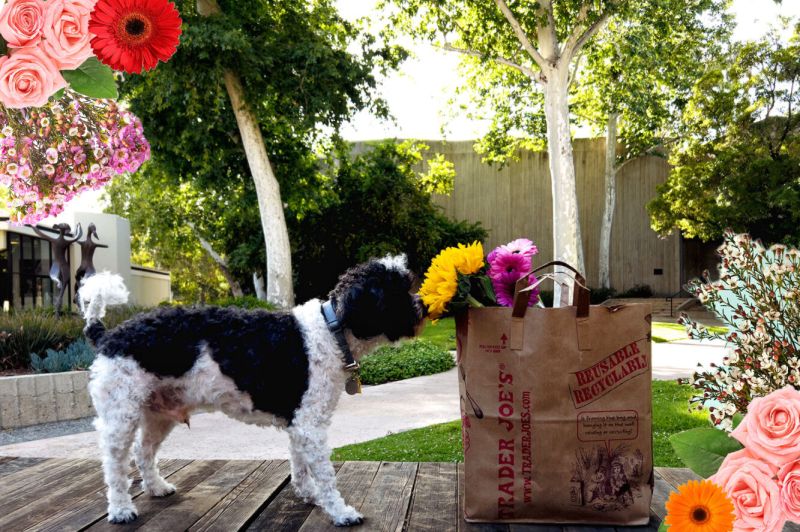Best Dog Friendly Garden Plants – The weather is warming and spring flowers are blooming. Now is the time to make your garden safe and beautiful for you and your furry friend.
Many herbs are good choices for a dog-friendly garden. You can grow them in containers or flower beds, so they are perfect for small spaces as well as large gardens.
Best Dog Friendly Garden Plants

As for flowers, options include marigolds, marigolds and sunflowers. If you have other pets, such as cats, make sure your plants are safe for them, as this can vary.
Make Your Garden A Pooch Friendly Paradise
Sage: Another aromatic herb that your dog can smell. Flowers range from blue to purple depending on variety.
Marigold: A garden plant with yellow or orange flowers, marigolds will brighten up your border without harming your furry friend.
Although these plants are good for dog-friendly gardens, remember that any plant can cause problems if your dog eats too much.
Some plants commonly found in our gardens are poisonous to dogs. It’s best to avoid planting them or find a way to keep your dog away, such as building a secure dividing fence that your dog can’t cross.
Best And Worst Flowers And Plants For A Pet Friendly Garden
Some of these plants are so poisonous that they can be fatal if eaten by a dog. Symptoms vary, but may include vomiting, lethargy, hyperactivity, and difficulty breathing. Keep seeds, bulbs and plants (not yet planted) out of your dog’s reach.
The things we use in gardens and outdoors can be toxic or even fatal to our dogs. See the Poisonous Plants and Substances page for a complete list.
If possible, avoid using them or keep them away from your dog’s cold mouth. Consider switching to organic gardening.

If you think your dog has eaten a poisonous plant or substance, see your vet right away, as symptoms are not always immediately apparent. Symptoms can include vomiting, diarrhea and skin irritation, depending on the plant or substance and how much your dog has eaten.
Pet Friendly Weed Killer Options For A Safe And Beautiful Yard
Your dog may have an allergy or sensitivity to a plant or substance not listed on our website.
It’s a good idea to check your dog’s coat, skin and ears regularly for redness and irritation. This will help you find out if they are sensitive or allergic to other plants or substances. If you are concerned, it is important to talk to your vet.
While keeping your garden safe for your dog, there are things you can do to make it more enjoyable. Offering plenty of activities in the garden encourages natural dog behaviors such as sniffing, foraging and exploring. It’s a simple way to enrich their lives and improve their well-being.
Over-excited dogs may feel calmer when given opportunities for activities in the garden. And for urban dogs whose walks are usually on city streets, this may be their only chance to get to know plants and other natural elements.
Dog Friendly Ornamental Grasses
Dogs kick for a variety of reasons. They may be looking for the source of the pleasant odor from the sweat glands on their feet. They may rough up the ground to make a cool, comfortable place to rest, or to bury something they want to keep for later.
Digging is a natural behavior for dogs and something they don’t want to do. Stopping them from digging altogether may make them sad or upset. However, you can help your dog dig in a way that keeps him entertained and protects your flower bed.
Teach your dog to dig in this area by scattering or burying treats to find them. You can also partially bury their outdoor toys for digging.

If you start digging around the kick box, your dog will learn what you are doing and copy you. The more he pays to dig the land, the more he will come back.
Garden Nasturtium Is Not Toxic To Dogs 🐾
If they start digging elsewhere in the garden, just walk into the hole and start hiding your food in it so they can come and see what you’re doing. They know that they will be rewarded for leaving the land to be dug.
Don’t have a garden or plot of land to dig a hole in? Using a cardboard box filled with shredded newspaper, you can make an indoor or backyard digging box. Hide toys and treats for your dog to dig into – he’ll love it.
When it’s hot outside, make sure your dog always has access to water and shade. Our hot weather tips include top tips and emergency tips for hot summer days.
Gardens are great places for people, but don’t forget your loyal friends. Transform your green space into a welcoming place with safe plants and fun things to do. You and your dog can enjoy the outdoors for months. From insurance to borders to protecting your plants, here are our tips to make sure your garden is dog-friendly.
Dog Friendly Landscape Design Ideas
Gardens can be a wonderful, stimulating place for dogs. However, dogs can cause damage by digging up plants and urinating on grass.
There are dangers in gardens too – some plants are potentially toxic to dogs and there are other dangers from harmful chemicals to sharp objects.
There are many things you can do to live in harmony with your four-legged friend, including planting non-toxic plants, creating dog-friendly areas and keeping your garden safe.

Creating different routes through the garden, such as well-defined paths and designated areas for playing or digging, will excite your dog. Different surface textures stimulate the underfoot, while grasses and ornamental grasses dance, sway and provide entertainment.
Pet Safe Flowers: Non Toxic For Cats & Dogs
Noisy dogs can damage young plants or plants with sensitive stems by digging or stepping on them. Plant large, established perennials and choose hardy plants such as nepeta, astilbe and hardy geraniums
A species that is poisonous to dogs and has the confusingly common name of geranium). Use a good spine of vigorous shrubs such as viburnum or bush roses.
Many garden plants can be poisonous to dogs. These include chrysanthemums, aconites, marigolds, narcissus, marigolds, delphiniums, foxgloves, hydrangea, oaks, tomatoes, wisteria and holly (Taxus baccata). If you notice any alarming symptoms and think your dog has ingested part of the plant, take your pet to the vet. Watch our video on plants that are poisonous to dogs.
Dogs can damage lawns and borders, so create a designated area for playing or digging with sand or bark. To prevent a dog from running across your borders, you can create paths through them or create well-defined boundaries such as low-growing hedges. Raised beds are also a great option.
Best Dog Friendly California Vacations For Your Pup
If you have a dog, you can still have a beautiful garden – many plants are not dangerous to dogs. These include pansy, aster, camellia, rose, sunflower, elaagnus, centaurea (corn oil), impatiens and calendula.
Some dogs will dig under fences or escape through holes in fences, so make sure your base has strong boundaries. Dogs can jump surprisingly high, so if you have a medium-sized dog, make sure your fence is at least 6 feet tall. Always keep the gates secure.
Test your dog to make sure he doesn’t eat any snails or snails. Avoid using non-organic hats as they are toxic to all wildlife. Pneumonia is spread by eating infected snails, slugs or frogs. Symptoms include difficulty breathing, coughing, lethargy, and bleeding that lasts longer than usual.
Shelters can contain dangerous chemicals and sharp instruments – they should always be kept tightly closed.
Non Toxic Plants For Pets
Avoid using chemicals such as inorganic slug pellets, which can be harmful if your dog eats slugs or snails. Learn how to treat snails and slugs organically. And do not add additives to water bodies or ponds, as dogs will be tempted to drink from them.
Like chocolate, this byproduct of the chocolate industry can be harmful when consumed – and the smell of chocolate is tempting. Use an alternative mulch such as bark.
Compost bins containing food waste can be attractive to dogs and contain contents that can harm them. Some foods like avocados, grapes, raisins and onions can be harmful, so make sure they don’t end up in your bin.
Yellow spots appear when weeping on grass. Train your dog not to howl on the grass or litter the area afterwards. Learn more about dog urine on grass.
Indoor Plants Safe For Cats And Dogs
Better to be safe than sorry. If your dog is showing signs of illness after eating a garden plant, slime or snail, don’t hesitate to take him to the vet.
Subscribe today for £19.99 for every 6 issues and get a 2 for 1 access card and picnic blanket.
The July issue of BBC Gardeners’ World is on sale now, buy online or in stores now.

Browse our seasonal garden selections from our trusted suppliers to save on what you need
Best Dog Friendly Houseplants
Dog friendly house plants, best dog friendly plants, dog friendly garden plants, best house plants dog friendly, dog friendly landscaping plants, best pet friendly plants, dog friendly indoor plants, dog friendly outdoor plants, dog friendly plants, best cat friendly plants, best cat friendly indoor plants, best indoor plants dog friendly

